The Permanent Maxillary Incisors
There are eight incisors in the permanent dentition; four each in the maxilla and the mandible. The incisors on either side of the midline are called the central incisors. These are the only teeth in the dental arch with the mesial surfaces in contact with each other.
Table of Contents
The teeth that are distal to the central incisor are called the lateral incisors.
There are two central incisors and two lateral incisors in each arch. The central incisor is larger than the lateral incisor. Incisors help in cutting and shearing of the food. They also play an important role in speech and aesthetics.
Read And Learn More: Oral Anatomy Notes
| Body Fluids | Muscle Physiology | Digestive System |
| Endocrinology | Face Anatomy | Neck Anatomy |
| Lower Limb | Upper Limb | Nervous System |
Class Traits Of Incisors
- The characteristics that are common to all the incisors are referred to as class traits of incisors.
- Incisors develop from four lobes; three labial and one lingual.
- Mamelons are rounded eminences on the incisal aspect of the newly erupted incisors.
- The crowns are trapezoidal from the labial aspect and wedge-shaped/triangular from the proximal aspect.
- The incisal aspect is similar to the edge of a blade.
- The mesial and distal contact areas are small and almost at the same level, more often in the mandibular incisors.
- The incisors possess a cingulum in the cervical third of the lingual aspect and a lingual fossa in the centre of the lingual aspect.
- The labial surface is convex and the lingual surface is concavo-convex.
- The labial and lingual crest of curvatures are in the cervical third.
- The cervical line has greater curvature on the proximal aspect than on other teeth.
- The incisors are important for aesthetics and phonetics and are placed in the centre of the arch anteroposteriorly.
- They have a single conical root tapering towards the apex.
The Permanent Maxillary Central Incisor
The maxillary central incisor is the widest of all anterior teeth. A newly erupted central incisor may exhibit mamelons on the incisal ridge. The mamelons are worn out with mastication and gradually disappear with advancement in age. The maxillary central incisor is present in the midline and is of high aesthetic value. The morphology of this
The tooth will be described from the labial, lingual, mesial, distal and incisal aspects. The nomenclature, chronology and measurement of the maxillary central incisor are given in tables.

Nomenclature: Maxillary central incisor:

Maxillary central incisor: Chronology and measurements:

Labial aspect:
Features of the crown:
Shape and surface:
- The shape of the crown is trapezoidal. The tooth converges and thus Becomes narrower towards the cervical line where the crown joins the Root.
- The surface is flat in the middle and incisal third; and convex in the cervical third. The developmental lines that divide the labial surface into three parts represent the three lobes from which the tooth develops.
Mesial outline:
- The mesial outline is slightly convex or straight.
- The mesial contact area is in the incisal third approaching the mesioincisal Angle.
Distal outline:
- The distal outline is more convex than the mesial outline.
- The distal contact area is in the incisal third, more cervical than the mesial contact area.
Incisal outline:
- The incisal outline is straight in a mesiodistal direction in the centre With a sharp mesioincisal angle and rounded distoincisal angle.
Cervical line:
- The cervical line is semicircular in outline and curved towards the root.
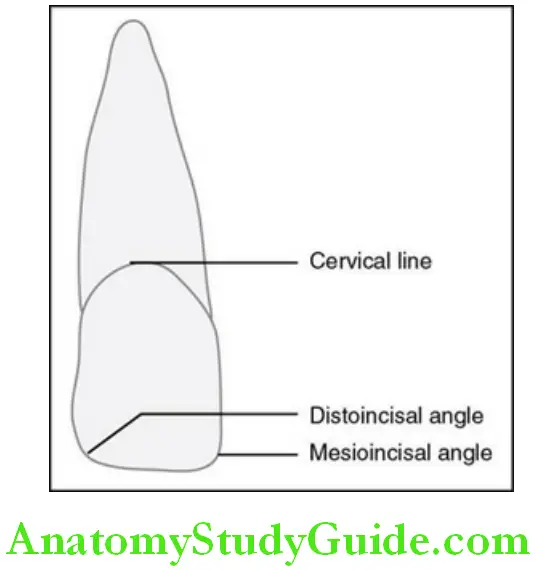
Features of the root:
- The root is conical in shape with a blunt apex.
- The centre of the root is parallel to the mesial outline of the crown.
Lingual aspect:
Features of the crown:
Shape and surface:
- The outline is the reverse of the labial outline.
- The surface has convexities and a concavity.
- The proximal sides of the crown and root taper towards the lingual
Side; thus a part of the mesial and distal surfaces are visible. This is known as lingual convergence.
Cingulum:
- The cingulum is a smooth convexity present within the cervical third of the Lingual surface.
Lingual fossa and marginal ridges:
- The centre of the lingual portion of the central incisor below the
The cingulum has a concavity called the lingual fossa. It is w shaped. - It is bounded:
- Mesially by the mesial marginal ridge
- Dstally by the distal marginal ridge
- Superiorly by the cingulum
- Inferiorly by the linguoincisal ridge which is the lingual Portion of the incisal ridge
- Marginal ridges – The linear elevations that form the border of the Lingual aspect are called the marginal ridges.
- The ridge on the mesial side is the mesial marginal ridge.
- The ridge on the distal side is the distal marginal ridge.
- Deep developmental grooves might extend from the cingulum into the Lingual fossa.
Cervical line:
- The cervical line is semicircular with the curvature towards the root.
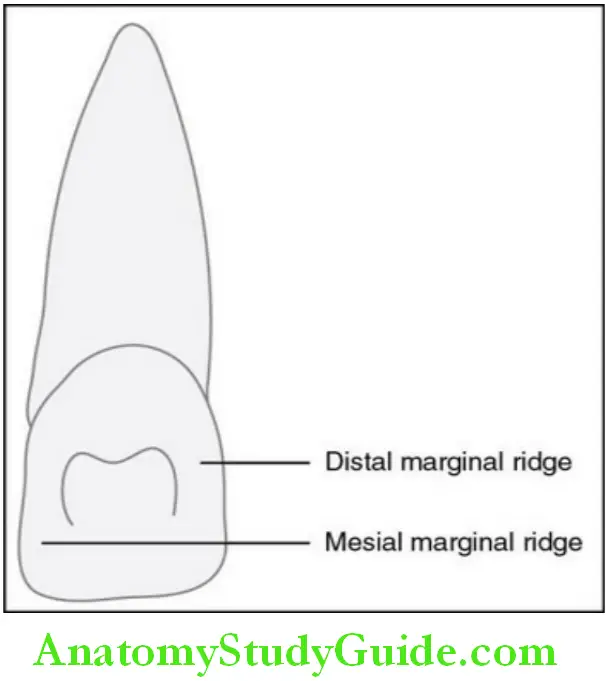
Features of the root:
The root tapers towards the lingual aspect. It ends in a blunt apex.
It is triangular in cross-section with rounded angles with the mesial, distal and labial sides forming the three sides of the triangle.
Mesial aspect:
Features of the crown:
Shape and surface:
- The crown is triangular or wedge shaped with the cervix forming the Base and the incisal edge being the apex of the triangle.
- The surface is convex and smooth.
Labial and lingual outline:
- The labial outline is convex in the cervical third and is straight beyond the cervical third to the incisal ridge.
- The labial crest of curvature is in the cervical third.
- The lingual outline is convex in the cervical third and above the Cingulum the outline in concave due to the presence of the lingual Fossa.
- The lingual crest of curvature is at the cingulum located in the cervical third.
Incisal ridge:
- A line bisecting the crown and the root will bisect the incisal ridge.
Cervical line:
- It is curved towards the crown with the curvature being more on the Mesial side than the distal side.
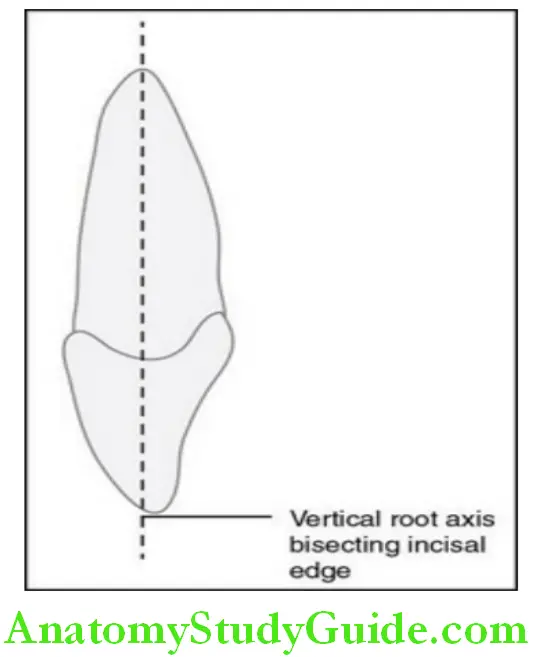
Features of the root:
- The root is cone shaped with a blunt, rounded apex.
Distal aspect:
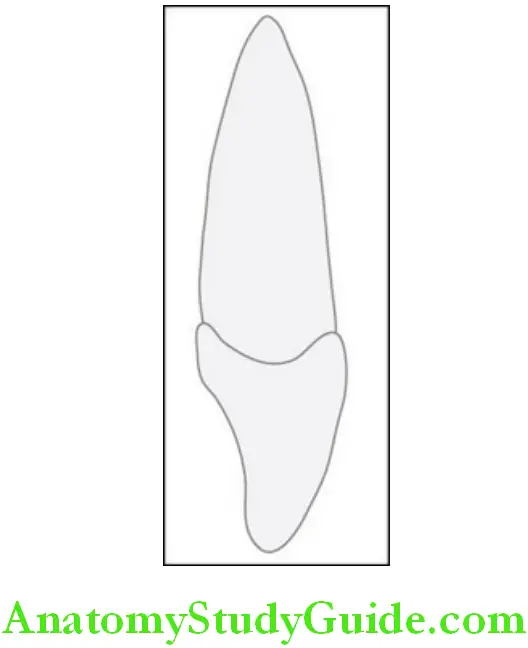
The distal aspect of the central incisor differs from the mesial aspect as:
- The crown appears thicker and wider in the incisal third. More of the labial surface is seen due to the labial surface sloping distolingually. The crown twists a little over the root to adapt to the curvature of the dental arch.
- The curvature of the cervical line is more on this aspect than the mesial aspect.
Incisal aspect:

This view can be appreciated by holding the tooth with the incisal ridge towards oneself.
- Crown: The root is not visible from this aspect due to the superimposition of the crown over the root.
- The labial face of the crown is flat and broad in the incisal third compared to lingually.
- The incisal ridge is seen from this aspect. It is differentiated from the incisal edge as the incisal ridge slopes lingually.
- The lingual outline tapers towards the cingulum which makes up the cervical third of the lingual surface.
- The tooth is triangular in shape from the incisal aspect with the labial surface forming the base, the proximal surfaces forming the sides and the apex towards the cingulum.
- The mesioincisal and the distoincisal line angles are prominent from this aspect.
- The mesiodistal dimension of the crown is more at the labial line angles than the lingual line angles.
- The outline of the incisal aspect is uniform bilaterally.
- The features that can help in identification of the maxillary central incisor.
Features to identify the permanent maxillary central incisor:
- Sharper mesioincisal line angle and rounded distoincisal angle
- W-shaped lingual fossa
- The incisal edge is straight
Features To Differentiate Between The Right And Left Maxillary Central Incisor
- Sharp mesioincisal angle; rounded distoincisal angle
- Straight mesial outline; rounded distal outlines
- The distal contact area more cervical than the mesial contact area
Development And Landmarks Crown And Root Of The Permanent Maxillary Central Incisor
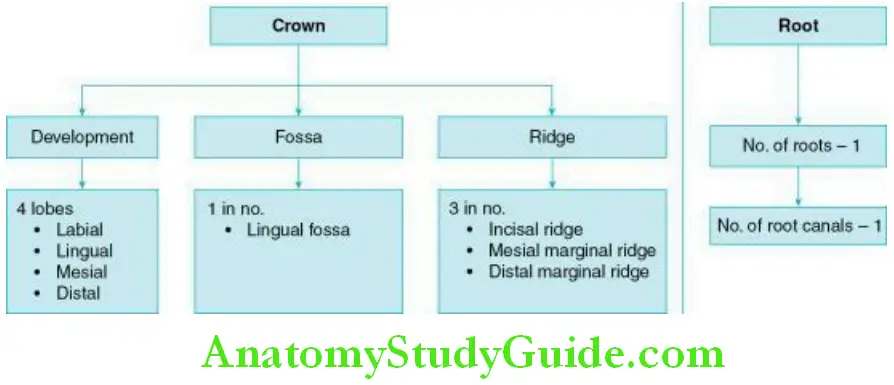
Variations And Developmental Anomalies
1. Shovel-shaped incisors – incisors with prominent marginal ridges and a deep lingual fossa.
2. Talon’s cusp – an incisor with a prominent cingulum resembling an eagle’s talon. This cingulum may interfere with occlusion. Such incisors are more prone to caries.
3. Screw driver-shaped tooth/Hutchinson incisors – in individuals affected with congenital syphilis, the incisors assume the shape of a screwdriver. The mesial and distal outlines converge due to the absence of the middle lobe, thus making the incisal third much narrower than the cervical third.
The Permanent Maxillary Incisors Synopsis
Labial aspect:
Crown:
- The shape of the crown is trapezoidal.
- The mesial outline is straight; the mesial contact area approaches the mesioincisal angle
- The distal contact area is in the incisal third, more cervical to the mesial contact area.
- The incisal outline is straight with a sharp mesioincisal angle and rounded Distoincisal angle.
- The cervical line is curved towards the root.
Root:
- Conical in shape with a blunt apex; the centre of the root is parallel to the mesial outline of the crown.
Lingual aspect:
Crown:
- The shape of the crown is trapezoidal.
- Lingual convergence is seen.
- The cingulum is seen within the cervical third.
- W-shaped lingual fossa bordered by the marginal ridges, cingulum and Linguoincisal ridge.
- Deep developmental grooves might extend from the cingulum into the lingual fossa.
Root:
- Triangular in cross-section with rounded angles. The mesial, distal and labial sides form the three sides of the triangle.
Mesial aspect:
Crown:
- Triangular or wedge-shaped.
- The labial outline is convex in the cervical third which is the labial crest of curvature.
- The lingual outline is convex in the cervical third due to the presence of the cingulum which is the lingual crest of curvature.
- A line bisecting the crown and the root will pass through the incisal ridge.
- The cervical line is more curved towards the crown than the distal side.
Root:
- Cone-shaped with a blunt rounded apex.
Distal aspect:
Crown:
- It appears thicker and wider in the incisal third.
- The curvature of the cervical line is less on this aspect than the mesial aspect.
Incisal aspect:
Crown:
- The tooth is triangular in shape.
- The labial aspect appears semicircular; the cingulum makes up for most of the cervical portion of the crown on the lingual aspect.
The Permanent Maxillary Lateral Incisor
- The teeth that erupt distally to the central incisor are called the lateral incisors.
- The crown of the lateral incisor is similar to the central incisor and supplements it in function.
- The dimension of the lateral incisor is smaller than the central incisor except for the root Length.
- The morphology of this tooth will be described from the labial, lingual, mesial, distal and incisal aspects.
- The nomenclature, chronology and measurement of the maxillary central incisor are given in tables.
Nomenclature: Maxillary lateral incisor:

Maxillary lateral incisor: Chronology and measurements:
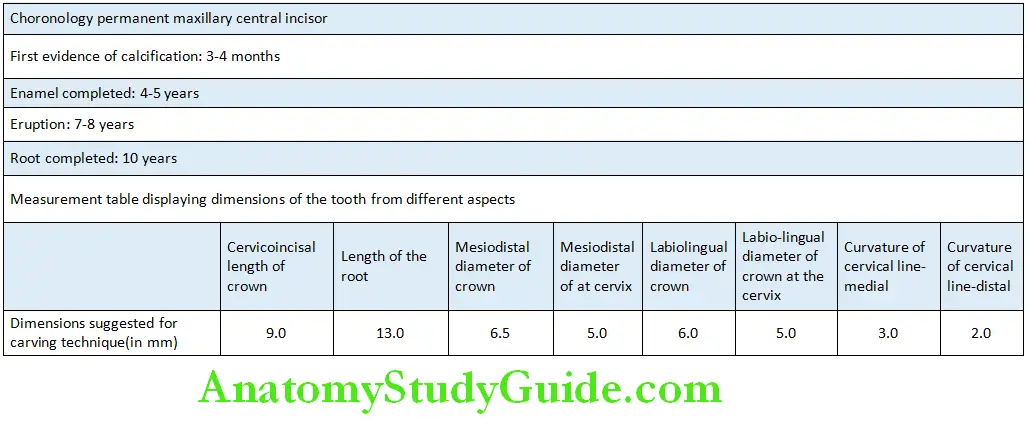
Labial aspect:

Features of the crown:
Shape and surface:
- The lateral incisor is not as symmetrical as the central incisor.
- The tooth has more curvature than the central incisor with rounded Mesioincisal and distoincisal angles and also incisal edges.
- The surface of the lateral incisor is more convex than the central incisor. A variant with a flat surface may also be seen.
Mesial outline:
- The mesial outline is convex and similar to the central incisor.
- The mesioincisal angle is more rounded than that of the central incisor.
- The mesial contact area is at the junction of the middle and incisal Third.
Distal outline:
- The distal outline is more convex and rounded than the mesial outline.
- In some, a semicircular distal outline is observed from the cervix to the incisal ridge through the rounded distoincisal line angle.
- The distal contact area is cervically placed compared to the mesial Contact area and is at the middle of the middle third.
Incisal outline:
- The incisal ridge is rounded with the rounded mesioincisal angle in comparison to the central incisor.
- The distoincisal angle is more rounded than the mesioincisal angle.
Cervical line:
- The cervical line is semicircular and curved towards the root.
Features of the root:
- The root is narrow and is approximately 1.5 times the length of the crown.
- It tapers from the cervical to the apical one-third.
- It often curves distally and ends in a pointed apex; straight roots might also be seen.
Lingual aspect:
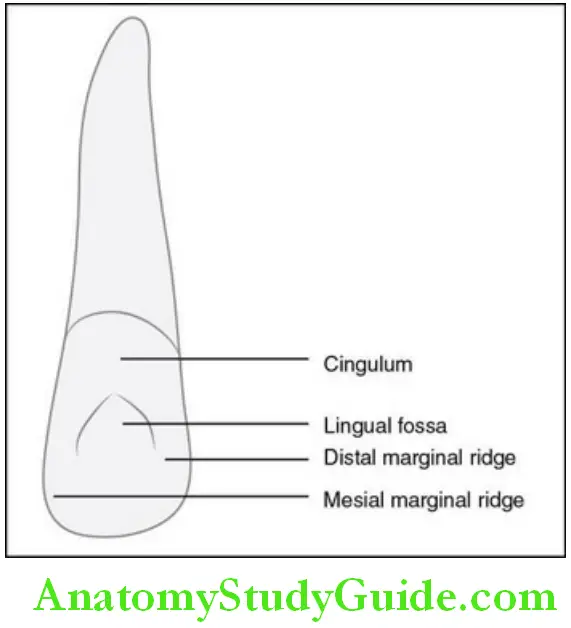
Features of the crown
Shape and surface:
- The shape is trapezoidal.
- The surface has convexities and a concavity and shows lingual convergence.
Cingulum:
- The cingulum is a smooth convexity present within the cervical third of the Lingual aspect immediately below the cervical line.
- The cingulum is Prominent but is smaller in dimension than in the central incisor and is In the centre mesiodistally.
- A deep developmental groove may be seen on the distal side of the Cingulum; it may extend from the lingual fossa up to the root or along The entire length of the tooth.
Lingual fossa and marginal ridges:
- The concavity on the lingual aspect is called the lingual fossa.
- It is v-shaped, deep and more prominent than in the central incisor.
- The lingual fossa is bounded:
- Mesially by the mesial marginal ridge
- Distally by the distal marginal ridge
- Superiorly by the cingulum
- Inferiorly by the linguoincisal ridge
- The marginal ridges are more marked than in the central incisors and The linguoincisal ridge is well developed.
Features of the root:
- The root tapers towards the lingual aspect with the apex exhibiting a distal tilt.
Mesial aspect:
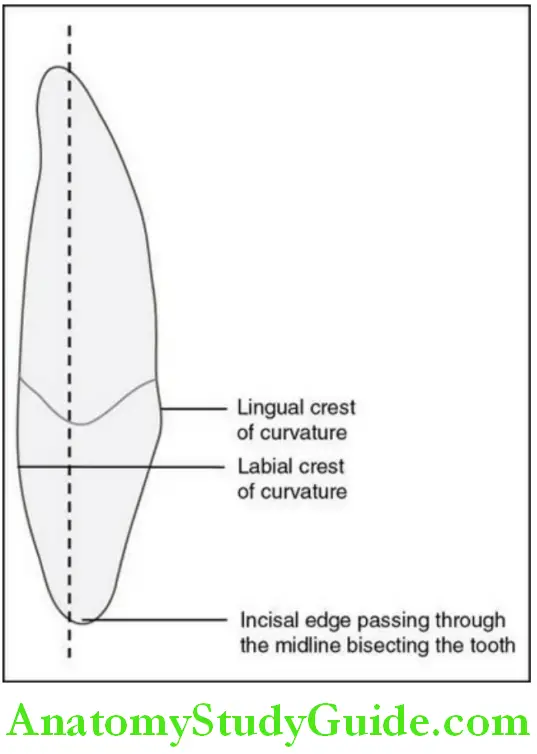
The mesial aspect of the lateral incisor resembles a smaller central incisor except for the root being longer.
Features of the crown:
Shape and surface:
- The crown is triangular or wedge shaped with the cervix forming the Base of the triangle and the incisal edge being the apex of the triangle.
- The surface is convex and smooth.
Labial and lingual outline:
- The labial outline is convex till the crest of curvature and then Relatively straight.
- The labial crest of curvature is in the cervical third.
- The lingual outline is convex in the cervical third (due to the presence of the cingulum) and concave till the incisal ridge (due to the presence of the lingual fossa). There is a slight convexity due to the thick incisal ridge in the incisal third.
- The lingual crest of curvature is in the cervical third.
Incisal ridge:
- The incisal edge appears thicker than the central incisor due to heavy Development.
- A line bisecting the crown and the root will bisect the incisal ridge.
Cervical line:
- The cervical line is curved towards the crown with the curvature being More on the mesial side than the distal side.
Features of the root:
- The root is tapered cone-shaped with a blunt rounded apex.
Distal aspect:
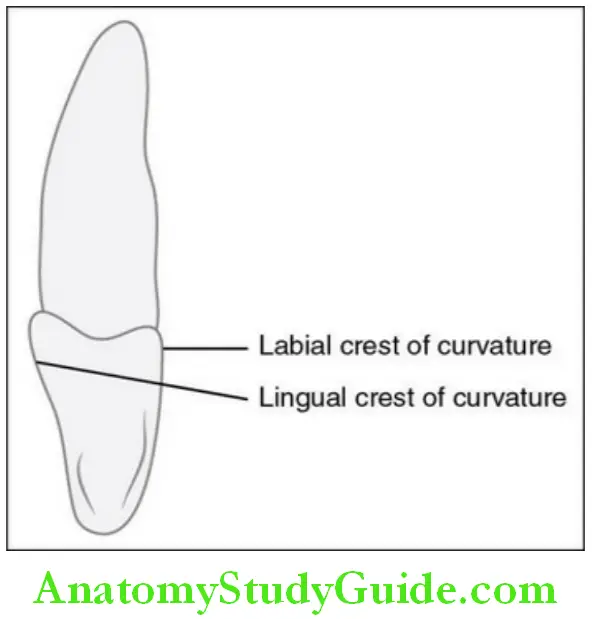
The distal aspect differs from the mesial aspect in the following:
- The placement of the crown over the root makes the width of the crown appear thicker on the distal aspect than the mesial aspect.
- Lesser curvature of the cervical line is seen.
- A developmental groove may be seen extending along the entire length of the root.
Incisal aspect:
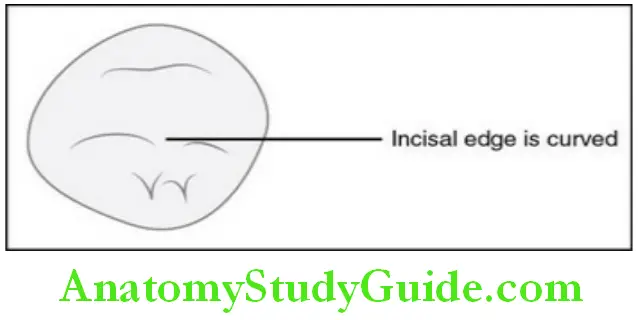
- Greater convexity labially and lingually is observed from the incisal aspect in the maxillary lateral incisors compared to the central incisors.
- The incisal aspect is similar to that of the central incisor or a small canine.
- In a lateral incisor resembling the canine, the labiolingual dimension is greater than the mesiodistal dimension, with a large cingulum and incisal ridge.
- The features that can help in the identification of the maxillary lateral incisor are given in the box.
Features to identify the maxillary lateral incisor:
- Rounded mesioincisal line angle and more rounded distoincisal angle
- V-shaped lingual fossa
- Rounded incisal ridge
- Incisal edge sloping from the mesioincisal to the distoincisal line angle
Features To Differentiate Between The Right And Left Lateral Incisor
- The distoincisal angle is more rounded than the mesioincisal line angle.
- The incisal edge slopes from mesially to distally.
- The distal outline is more rounded compared to the mesial outline.
Development And Landmarks Crown And Root Of The Maxillary Lateral Incisor

Variations In The Development Of The Lateral Incisor
The maxillary lateral incisor exhibits the highest variation in form and size in the oral cavity after the third molars. The variations include the following:
- Peg-shaped laterals – pointed or conical-shaped lateral incisor. It might also be a manifestation secondary to congenital syphilis.
- Missing lateral incisors – the lateral incisor may be missing or congenitally absent.
- Palato-radicular groove – the groove extending from the cingulum to the root surface is the palato-radicular groove which may be a predisposing factor to periodontal disease.
- Talons cusp – the cingulum in some lateral incisors is very prominent and may resemble the eagle’s talon.
- This makes the tooth more prone to caries and could also interfere with occlusion.
- Shovel-shaped lateral incisors – a lateral incisor with prominent marginal ridges and deep lingual fossa
The Permanent Maxillary Incisors Synopsis
Labial aspect:
Crown:
- The shape of the crown is trapezoidal.
- Rounded mesioincisal, distoincisal angles and incisal edges.
- The mesial outline is convex; the mesial contact area is located at the junction of the middle and the incisal third.
- The distal outline is more convex and rounded than the mesial outline; the distal contact area is in the middle of the middle third.
- The incisal ridge is rounded with rounded mesioincisal; the distoincisal angle is more rounded than the mesioincisal angle.
- The cervical line is semicircular with the curvature towards the root.
Root:
- The root is narrow and longer than in the central incisor. It tapers from the cervical line to the apical one-third.
Lingual aspect:
Crown:
- The lingual outline is the reverse of that of the labial outline; lingual convergence is seen.
- The surface in comparison has a cingulum, lingual fossa and marginal ridges.
- The cingulum is a smooth convexity present within the cervical third.
- The lingual fossa is the concavity on the lingual aspect and is v-shaped.
- Marginal ridges form the boundaries of the lingual fossa.
Root:
- It tapers towards the lingual aspect with the apex exhibiting a distal tilt.
Mesial aspect:
Crown:
- The shape is triangular or wedge-shaped; the surface is convex and smooth.
- The labial outline is convex; the labial crest of curvature is in the cervical third.
- The lingual outline is convex in the cervical third.
- The incisal ridge appears thicker due to heavy development.
- A line drawn through the crown and the root through the centre of the tooth will bisect the apex and the incisal ridge of the crown.
- Cervical line: This is curved towards the crown with the curvature being more on the mesial side.
Root:
- The root is tapered cone-shaped with a blunt rounded apex.
Distal aspect:
Crown:
- The placement of the crown over the root makes the width of the crown appear thicker than on the mesial aspect.
- A developmental groove may be seen extending along the entire length of the root.
Incisal aspect:
Crown:
- The incisal aspect is similar to that of the central incisor or a small canine.
- The cingulum and the incisal ridge may be larger in the central incisor.
Differences Between The Permanent Maxillary Central And Lateral Incisor
Differences between the maxillary central and lateral incisor:
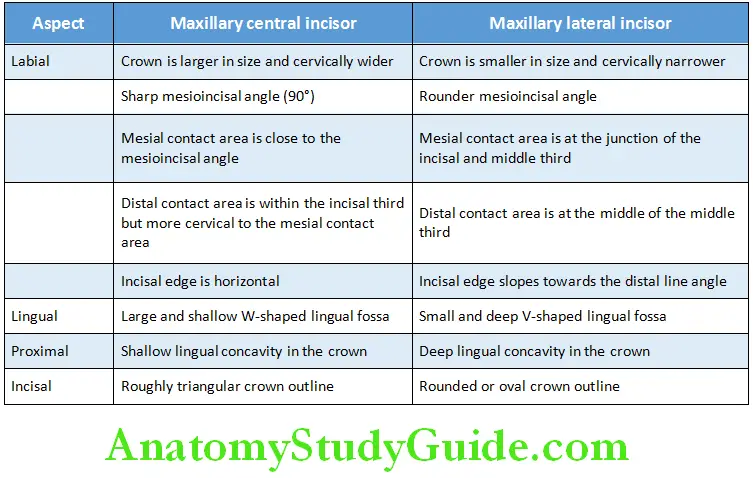
Leave a Reply